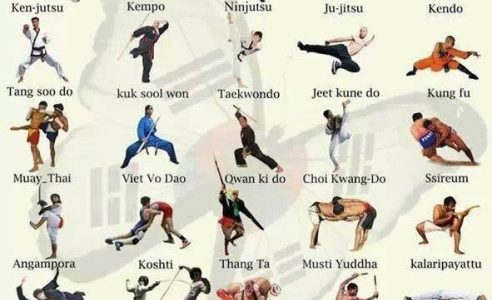Explore The Interesting Background Of Martial Arts, Following Its Development From Age-Old Techniques To The Sophisticated Methods Utilized Today. Reveal The Secrets That Make This Technique Timeless
Explore The Interesting Background Of Martial Arts, Following Its Development From Age-Old Techniques To The Sophisticated Methods Utilized Today. Reveal The Secrets That Make This Technique Timeless
Blog Article
Author-Bonner Whitaker
Enter the world of martial arts, where old beginnings and modern techniques collide in an exhilarating trip of discipline and self-discovery.
As you explore the background and evolution of this captivating art form, prepare to be mesmerized by the cultural influences, technological improvements, and extensive philosophy that have actually formed it over centuries.
From the battlefields of ancient worlds to the training premises of today, martial arts have stood the test of time, regularly adjusting and growing.
Each strike, each motion, brings with it the weight of many years of custom and wisdom, passed down via generations. This is a story of strength, of warriors who looked for not just physical prowess, but likewise self-confidence and harmony.
Join us on this exceptional exploration as we uncover the tricks, the legends, and the transformational power of martial arts.
Prepare yourself to be inspired, challenged, and permanently altered by the history and evolution of martial arts.
Social Impacts on Martial Arts
As you check out the background and evolution of martial arts, you'll promptly discover the interesting methods which social impacts have actually formed these battle techniques.
From the old people of China and India to the a lot more current advancements in Japan and Brazil, martial arts have been heavily influenced by the societies in which they originated.
As an example, Chinese martial arts, such as Kung Fu and Tai Chi, are deeply rooted in the philosophy of Taoism and the principle of Yin and Yang.
On the other hand, Japanese martial arts, like Karate and Judo, mirror the samurai warrior practices and the values of technique and honor.
Similarly, Brazilian fighting style, Capoeira, integrates components of African dance and music, showing the cultural heritage of African slaves in Brazil.
These social influences not only provide each fighting style its distinct characteristics but also provide a much deeper understanding of the historical and social contexts in which they developed.
Technological Improvements and Martial Arts
With the increase of sophisticated weaponry and innovative training tools, you have actually been able to enhance your abilities and adjust to the ever-changing fight landscape.
Technical innovations have changed the way martial arts are exercised and educated. Virtual reality simulations currently allow you to train in realistic combat scenarios without the threat of physical harm. High-speed cams catch every move, allowing you to assess and perfect your methods. Wearable gadgets monitor your heart price, breathing, and muscle activation, giving instant comments on your performance.
In addition, the growth of customized tools, such as resistance bands and dexterity ladders, has actually allowed you to enhance your rate, strength, and dexterity. https://cruzerdoy.win-blog.com/9929625/look-into-the-complex-cosmos-of-martial-arts-to-improve-your-health-and-fitness-and-total-well-being-launch-your-inner-warrior-and-take-the-initial-step-in-the-direction-of-becoming-a-healthier-and-more-durable-individual-today have not just made training more reliable yet have actually additionally pushed the limits of what is possible in martial arts, allowing you to reach brand-new elevations in your practice.
The Approach and Concepts of Martial Arts
The ideology and principles of martial arts are deeply rooted in shaping your frame of mind and instilling self-control, focus, and regard in your practice.
1. Attitude: Martial Arts instructs you to develop a strong and resistant attitude. see this website allows you to conquer difficulties both on and off the floor covering, pushing your limits and standing firm despite misfortune.
2. Discipline: Martial Arts demands discipline and self-constraint. Through https://snappedharlemwomanstabshu62851.nizarblog.com/30017910/take-a-look-at-the-considerable-differences-between-martial-arts-and-self-defense-discover-the-underlying-concepts-of-these-significant-methods-and-make-an-informed-choice-for-your-individual-securing and adherence to stringent regulations and methods, you discover to regulate your impulses and develop a strong job principles.
3. Emphasis: Martial Arts calls for intense emphasis and concentration. By training your mind to be present in the minute, you improve your capability to respond rapidly and efficiently throughout fight scenarios.
4. Regard: Martial Arts highlights regard for oneself, instructors, educating partners, and opponents. It shows you to value the skills and experiences of others, fostering a sense of sociability and sportsmanship.
Verdict
Congratulations on finishing your trip via the fascinating globe of martial arts! Throughout this expedition, you have actually seen the abundant background and exceptional advancement of these battle techniques.
From click for source to the modern-day techniques we see today, martial arts have actually been formed by cultural influences.
The integration of innovation has also played a substantial function in transforming the means martial arts are taught and exercised in the present day.
Nonetheless, it is essential to remember that martial arts are greater than just physical fight. They include profound philosophies and leading concepts that surpass the simple act of combating.
Take a moment to reflect on this anachronistic adventure and value just how the tradition of martial arts remains to thrive in the present, transcending time and limits.
